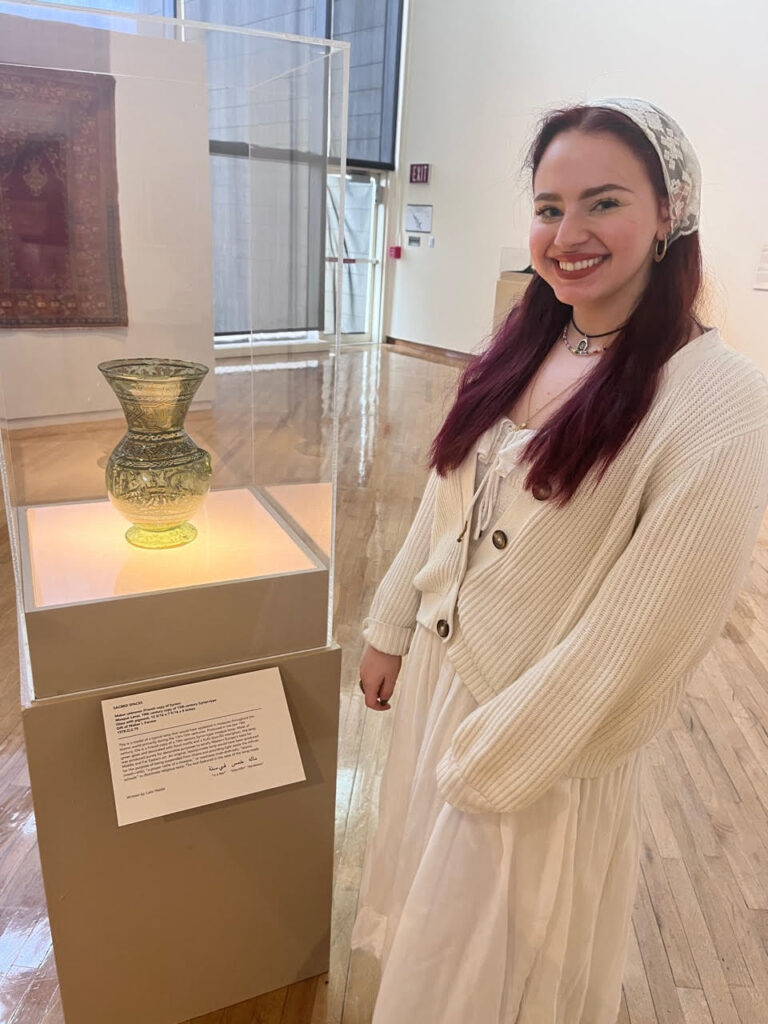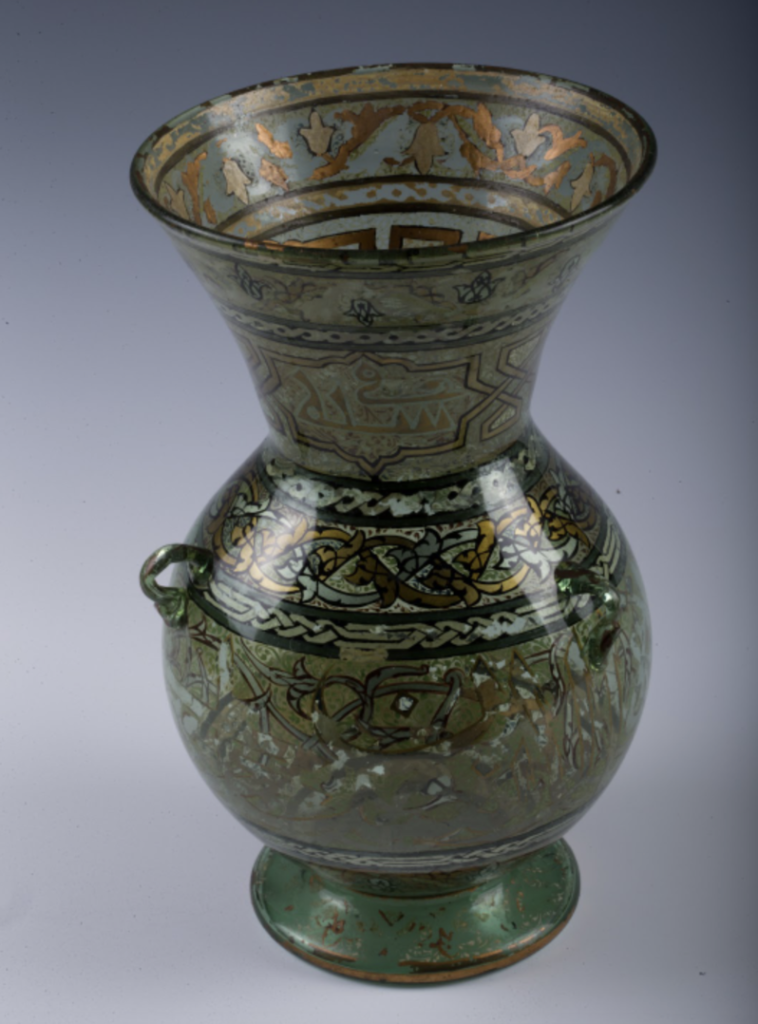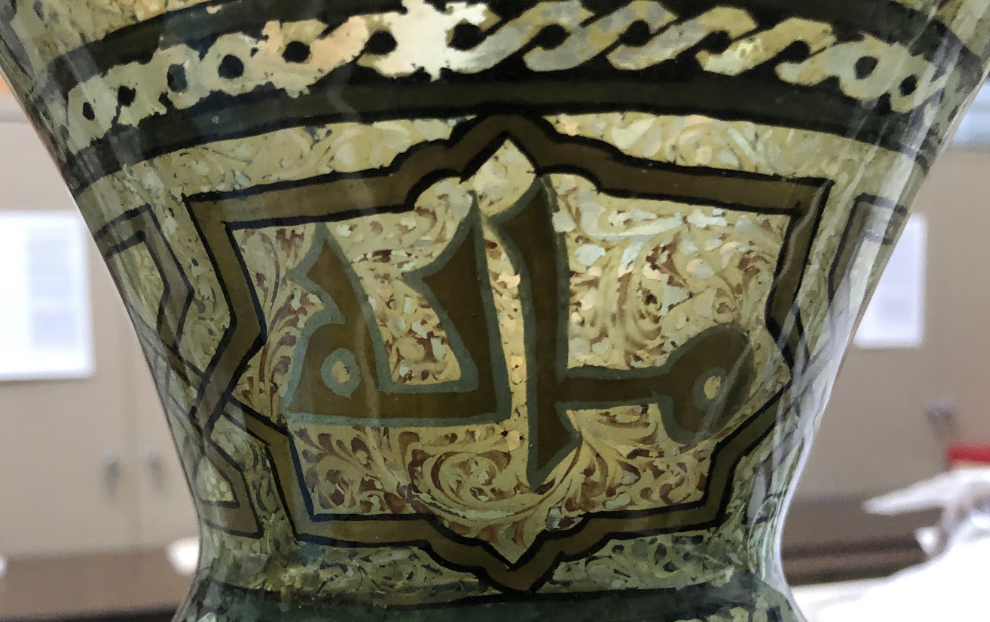
By: Laila Haidar

Hi there! My name is Laila Haidar, and I’m a student intern at the Richard & Carole Cocks Art Museum (RCCAM). I’m also Arab-American (of proud Lebanese heritage!), and I’m here to help celebrate Arab-American Heritage Month! Working at the museum, I’ve been lucky to spend time with lots of objects that originate from the same region as my family, and one object in particular, a mosque lamp, I was able to work with and research for the Art History Capstone Exhibition, Experiencing the Divine: Devotional Practices of Islam, Judaism, and Christianity. Now, I must note upfront that this object was NOT created by an Arab artist, but instead, by a French copyist. So why am I talking about it? Well, although the object is likely of French origin, it is believed to be a copy of a 15th century mosque lamp that was likely made in Syria. I’m speaking about this object specifically not only because I’ve studied it in depth, but because my heritage actually came in handy when trying to decipher the inscriptions located on the neck of the lamp.
For a little bit of background, it’s important to note that Islamic art, and consequently, much Arab art, does not have any figural representation (in other words, representations of faces and living figures) due to the abolition of graven images as stated in the Second Commandment. As such, Islamic art is typically composed of skillful calligraphy and frequently decorated with scrolling and winding vegetal and floral motifs. So, on this particular piece, the calligraphic inscription is a large part of the artwork.

Mosque Lamp, 19th century French copy of a 15th century Syrian-type lamp. Glass with pigment, 19.2 cm x 20.3 cm x 31.3 cm. Richard & Carole Cocks Art Museum.
When I was first given this piece to write about for the capstone, I knew that I had an advantage in terms of understanding it due to my heritage. I personally am unable to read Arabic, but my dad and most of my relatives on his side can both read and speak Arabic fluently. So, after photographing the inscriptions, I asked my dad if he could translate them. Initially, I was worried that the inscription might not be real Arabic, but pseudo-Arabic, which is just random forms meant to roughly resemble what non-Arabic reading audiences think Arabic looks like. This is because, when western artists created paintings and decorative arts for a European audience, they were really only doing so to satisfy western Europe’s taste for anything “exotic” that was especially prevalent in the 19th century. So, given that this lamp was likely created by a French artist, I knew it was entirely possible that the inscription could be pseudo-Arabic. However, my dad was able to come up with a rough translation. He had a bit of a hard time, given that the inscription was written in Kufic-style script, which, for aesthetic reasons, typically excludes diacritical marks that are necessary to differentiate letters. Luckily, my dad’s brother and sister came to town to visit us a few weeks later, and we all had a conversation about the lamp over dinner one night. My dad, aunt, and uncle all took turns passing around my phone, looking at the images of the inscription. After discussing it and looking at the context a bit, my family came up with the following translation, with the transliteration provided by Dr. Nathan French (translations correspond to the order in which the photos are presented):



Translations and transliterations:
māluhu — his money
khums – one fifth
fī sana – in a year
*Note: These translations were also reviewed and approved by Dr. Nathan French.
So, what does this all mean? My family, who is Shia (a sect of Islam), interpreted this as meaning one must pay one-fifth of their total wealth each year in almsgiving. Essentially, they explained it’s another form of tithing that Shia Muslims (as opposed to Sunni Muslims) are obliged to pay yearly in addition to zakat (the alms that all Muslims pay each year as stated in the Five Pillars of Islam), and this inscription was most likely a kind of instructional message. So, although this object is of French origin, it is indeed a copy of a real object created by an Arab artist centuries earlier, and still provides a fascinating window into the past.
I really valued my time working with this object, because what began as something I needed to research for class turned into a family affair. Being able to share my excitement and passion for art history with my family in a way that actively involved them was really special, and allowed me to learn a bit more about my own heritage from them. They were especially proud to see the object on display along with the label and translation that they helped write. So, that object took on much more meaning for me the more I worked with it, because to me, it’s no longer just a museum object, but an item that connected me more closely with my family and my Arab heritage.
